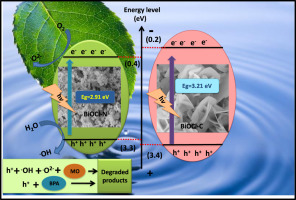Ecotoxicology and Environmental Safety ( IF 6.8 ) Pub Date : 2018-09-11 , DOI: 10.1016/j.ecoenv.2018.09.024 Seema Garg , Mohit Yadav , Amrish Chandra , Soniya Gahlawat , Pravin P. Ingole , Zsolt Pap , Klara Hernadi

|
The inducement of plant leaf extracts for the synthesis of various nanostructures has intrigued researchers across the earth to explore the mechanisms of biologically active compounds present in the plants. Herein, a green modified hydrolysis route has been employed for the synthesis of bismuth oxychloride i.e. BiOCl-N, BiOCl-T and BiOCl-A using plant extracts of Azadirachta indica (Neem), Ocimum sanctum (Tulsi), and Saraca indica (Ashoka), and; simultaneously, without plant extract (BiOCl-C), respectively. The as-prepared samples were examined by several microscopic and spectroscopic techniques which revealed that the biosynthesized BiOCl attained certain favorable features such as hierarchical nano-flower morphology, higher porosity, higher specific surface area and narrower band gap compared to BiOCl-C. The degradation of methyl orange (MO) and bisphenol A (BPA) using biosynthesized BiOCl were improved by 21.5% within 90 min and 18.2% within 600 min under visible light irradiation, respectively. The photocurrent response, electrochemical impedance spectroscopy (EIS) and photoluminescence (PL) studies indicated the effective inhibition of the electron-hole pair recombination and enhanced photocatalytic activity of the biosynthesized BiOCl.
中文翻译:

植物叶片提取物作为BiOCl对环境修复的光催化活性调节剂
诱导植物叶片提取物合成各种纳米结构的研究吸引了全世界的研究人员,以探索植物中存在的生物活性化合物的机制。在此,绿色改性水解路线已经用于氯氧化铋即的BiOCl-N,的BiOCl-T和的BiOCl-A的使用的植物提取物的合成印楝(印楝),圣罗勒(图尔西),和萨拉卡籼稻(Ashoka),以及;同时没有植物提取物(BiOC1-C)。通过几种显微镜和光谱技术检查了所制备的样品,发现与BiOCl-C相比,生物合成的BiOCl具有某些有利的功能,例如分层的纳米花形态,更高的孔隙率,更高的比表面积和更窄的带隙。在可见光照射下,使用生物合成的BiOCl降解甲基橙(MO)和双酚A(BPA)的降解分别在90分钟内提高了21.5%和600分钟内的18.2%。光电流响应,电化学阻抗谱(EIS)和光致发光(PL)研究表明,有效地抑制了电子-空穴对的重组并增强了生物合成BiOCl的光催化活性。


























 京公网安备 11010802027423号
京公网安备 11010802027423号